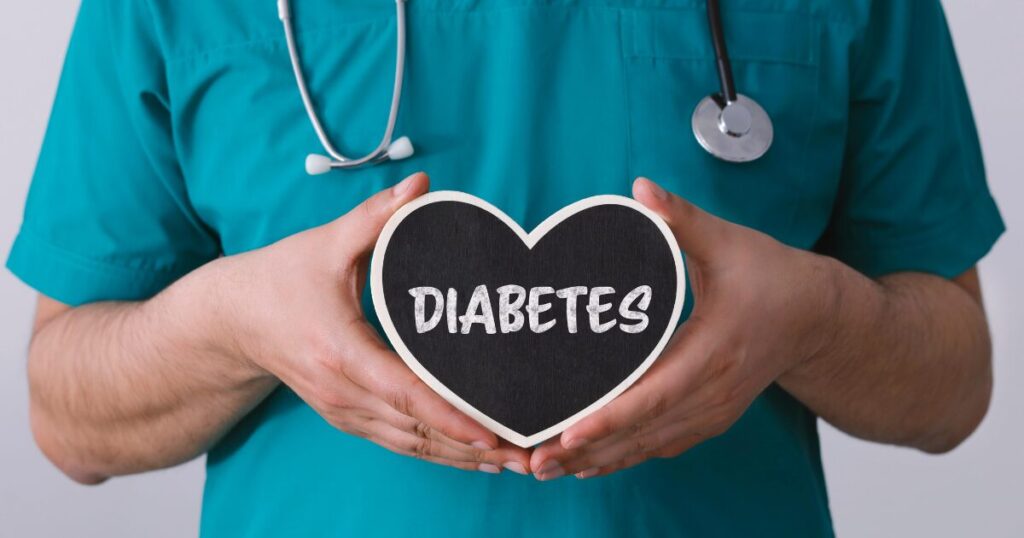Diabetes is a chronic disease that occurs when the body doesn’t produce enough insulin or cannot use insulin properly. It damages the heart, kidneys, nerves, blood vessels, and eyes if it isn’t managed.
What are the different types of diabetes?
What is type 1 diabetes?
Type 1 diabetes is less common than type 2 diabetes, and it can develop at any age, but it typically appears in children, teens and young adults. It causes the glucose level in your bloodstream to become too high, and it happens when your body cannot produce enough insulin.
What is type 2 diabetes?
Type 2 diabetes occurs when the body does not produce enough insulin or the body’s cells do not react to insulin. Type 2 diabetes tends to be associated with obesity and is mainly diagnosed in older people.
What are the symptoms of diabetes?
Symptoms of type 1 diabetes
- Increased thirst
- Urinating more than usual
- Feeling very tired
- Losing weight without trying
- Blurred vision
- Cuts & grazes that don’t heal
Symptoms of type 2 diabetes
- Increased thirst
- Urinating more than usual
- Feeling very tired
- Losing weight without trying
- Blurred vision
- Cuts & grazes that don’t heal
The symptoms of type 1 and type 2 diabetes are very similar; the only huge difference is the age range that they are commonly found in.
What causes diabetes?
The causes of type 1 diabetes
Type 1 diabetes is caused when your immune system attacks insulin-producing cells from the pancreas.
The causes of type 2 diabetes
Some of the causes of type 2 diabetes are:
- Being overweight
- An insulin resistance
- A bad diet
- Family history of type 2 diabetes
- Very little/lack of exercise
- Sedentary lifestyle
- Genetic mutations
Certain pre-existing conditions can also contribute to causing type 2 diabetes, such as:
- Cardiovascular disease
- Hypertension
- Obesity
- Stroke
- Polycystic ovary syndrome (PCOS)
- A history of gestational diabetes
Certain ethnic groups can also be more prone to type 2 diabetes. These ethnic groups include:
- South Asian
- Chinese
- African-Caribbean
- Black African
How do you get diagnosed with diabetes?
A doctor can diagnose diabetes by performing various blood sugar tests, such as an HbA1C test, a fasting blood sugar test, a glucose tolerance test or a glucose screening test. A doctor may also test urine for glucose and ketones, which can also indicate diabetes.
You can arrange these tests by contacting your GP.
You can also calculate your risk of getting diabetes.
Managing diabetes
How to manage type 1 diabetes
Taking insulin
Insulin is a natural hormone the pancreas produces that helps your body use the glucose in your bloodstream effectively. When you have type 1 diabetes, you stop producing insulin naturally, so you have to inject insulin to control your blood glucose levels regularly.
Counting carbs, protein and fats
Carb counting is an effective way of controlling your blood sugar levels. It helps your insulin dose match the amount of carbs you eat and drink.
Monitoring blood sugar regularly
Monitoring blood sugar allows you to monitor your glucose levels and ensure they remain safe. If blood sugar gets too high or low, you know it’s time to take your insulin or take action to raise it again.
Regular exercise and keeping at a healthy weight
Keeping active and exercising regularly helps the insulin in your body perform better (whether it’s the natural insulin or your insulin jab). Not only does it help with blood sugar, but it prevents other complications from diabetes.
The UK’s chief medical officer has published guidelines for efficient physical activity. We also offer advice guides on exercise and physical activity
How to manage type 2 diabetes
Healthy diet and exercise
Again, keeping active and exercising regularly helps the insulin in your body perform better (whether it’s the natural insulin or your insulin jab). Not only does it help with blood sugar, but it prevents other effects of diabetes, such as obesity and heart problems. We offer diet and nutrition advice alongside some healthy recipes.
Taking insulin, along with other medications that lower blood sugar
The primary role of insulin is to transport glucose from the bloodstream into the body’s cells, where it can be used for energy. Without sufficient insulin, glucose accumulates in the bloodstream instead of entering the cells to fuel the body.
Supporting your emotional health as well as physical
Stress hormones affect blood sugar a lot more than you would think. When we are stressed, our blood sugar levels spike and fall. For someone with type 2 diabetes, this means that their mental health and emotional stability can hugely affect how they treat themselves. Less stress means more regulated blood sugar.
Prediabetes medication (GLP-1s)
It should be safe for most people with prediabetes to take semaglutide. This is because semaglutide, the active ingredient in Ozempic and Wegovy, is most commonly used to control blood glucose levels in those with type 2 diabetes mellitus.
Many people who take semaglutide for weight loss have normal blood glucose levels; therefore, it should be safe for someone with slightly elevated sugars to take this medication.
However, you should also consider any other medications you may be taking. For example, some people with prediabetes are given medicines such as metformin to help reduce their blood glucose levels.
By combining two medicines that affect blood glucose, you may run the risk of hypoglycaemia. The potential for this and other adverse effects means we always recommend speaking to your GP if you have any concerns.
This is especially important if you’ve been told that your blood glucose levels are abnormal. Saxenda (which contains liraglutide, a similar medicine to semaglutide) is actually recommended for use in those with non-diabetic hyperglycaemia, also known as prediabetes.
This is because its action as a GLP-1 receptor antagonist can also help lower blood glucose levels to within a normal range. This is beneficial for those with prediabetes as it can help to prevent the onset of more dangerous conditions.
In addition, semaglutide acts as an appetite suppressant, which may help people lose weight. For a lot of people with prediabetes, this can often be enough to stabilise blood sugar levels.
As semaglutide works in a similar way to Saxenda (and Mounjaro, for that matter), it may also be suitable for those with non-diabetic hyperglycaemia. If you decide to start a weight loss consultation with myBMI, you will be asked about your blood glucose levels by our healthcare team.
This is so that our specialist prescribers can make an informed decision on the suitability of your treatment. If you aren’t sure what they are, you can ask your GP for a test.
Some pharmacies also offer diabetes screening tests that can check your glucose levels via blood and/or urine samples. If you have any concerns about prediabetes or semaglutide, we’d recommend speaking to your doctor.
Alternatively, if you decide to complete a consultation with myBMI, you could ask your prescriber anything you need to know.
Patient safety is at the core of our service, so we’d never prescribe something to you that we don’t think is suitable for you.
Not only that, but your prescriber will have the final say over your treatment, so they will always make the safest, most suitable choice before they write a prescription for any medication.








